| Share |  |
 | |||
Understanding Fats: The Good, The Bad and The BEST - Part Two
 In last month's article we looked at the various types of fats and the vital role they play in cellular communication, energy production, and in regulating various metabolic processes of the body. We also learned about "bad" fats produced artificially by man and how they lay a path for disease to follow by interfering with those metabolic processes. Our focus this month is on the "best" fats; the Omega fatty acids that, if balanced correctly, can prevent and alleviate many chronic inflammatory conditions experienced today.
In last month's article we looked at the various types of fats and the vital role they play in cellular communication, energy production, and in regulating various metabolic processes of the body. We also learned about "bad" fats produced artificially by man and how they lay a path for disease to follow by interfering with those metabolic processes. Our focus this month is on the "best" fats; the Omega fatty acids that, if balanced correctly, can prevent and alleviate many chronic inflammatory conditions experienced today.
There are two main polyunsaturated fats essential to health obtainable only through diet since the body cannot produce them. The primary omega-3 essential fatty acid is referred to as alpha-linolenic acid (ALA) and the primary omega-6 essential fatty acid is linoleic acid (LA). With these essential fatty acids present in the diet, the body is able to synthesize other kinds of omega-3 and omega-6 fatty acids that play vital roles in the health of the body. The fatty acids known to offer the widest array of health benefits are EPA (Eicosapentaenoic acid) and DHA (Docasahexaenoic acid) both of which are converted from omega-3 alpha-linolenic acid.
Omega-3 Keeps Hearts Healthy
The realization of just how beneficial omega-3 fatty acids are to cardiovascular health became apparent in the early seventies when Danish scientists observed a group of Arctic Eskimos who had exceptionally low rates of heart disease in spite of consuming a high fat and high cholesterol diet. Most of their fat calories came from fatty fish, seal and whale meat. Their blood samples showed high levels of omega-3s and very low levels of omega-6 fats. A similar reduction in heart and other major diseases has been observed in other populations who consume high omega-3 forms of seafood. According to a study published in the American Journal of Clinical Nutrition (July, 2003), patients who consumed the most omega-3 had a 55% lower risk of death from cardiovascular disease, heart attack, and stroke, and a 51% lower risk of death from coronary artery disease. Some of the ways omega-3 EPA works to reduce the risk of cardiovascular occurrences is by regulating heartbeat, dilating blood vessels, preventing blood clot formation and significantly regulating cholesterol and triglyceride levels.
"Food for Thought" - More than an Expression
 Our brains are 60% fat and Omega 3 fatty acids play an integral part of the structure and function of brain cell membranes. DHA is the main component of cell membranes in the nervous system and plays a major role in the maintenance of normal cognition and mood. It is largely responsible for the formation of the brain's synaptic connections, allowing various parts of the brain to communicate with each other and the rest of the body. When cell membranes don't have enough of the right fat, brain messages can be short-circuited and disturbances in mood, concentration, memory, attention and even behavior may result.
Our brains are 60% fat and Omega 3 fatty acids play an integral part of the structure and function of brain cell membranes. DHA is the main component of cell membranes in the nervous system and plays a major role in the maintenance of normal cognition and mood. It is largely responsible for the formation of the brain's synaptic connections, allowing various parts of the brain to communicate with each other and the rest of the body. When cell membranes don't have enough of the right fat, brain messages can be short-circuited and disturbances in mood, concentration, memory, attention and even behavior may result.
Research increasingly reveals low levels of DHA linked with such things as attention deficit disorder,  depression, bipolar and other mental disorders, memory loss, Alzheimer's, and dementia. In his book, The Memory Solution, Dr. Julian Whitaker referred to studies conducted in Japan indicating that supplemental DHA "sharpens memory in patients with dementia and depression and improves behavior and speech in those with Alzheimer's disease." Omega- 3 fatty acids not only help control chronic inflammatory processes responsible for degenerative brain function but also increase levels of serotonin that regulate mood and relieve depression. A study involving women showed those averaging the highest intake of oily fish had 25% less occasions of depressive symptoms and those averaging the highest intake of EPA and DHA had 34% less occasions of depressive symptoms. It has also been found that cultures that eat large amounts of fish have lower rates of depression than those that do not.
depression, bipolar and other mental disorders, memory loss, Alzheimer's, and dementia. In his book, The Memory Solution, Dr. Julian Whitaker referred to studies conducted in Japan indicating that supplemental DHA "sharpens memory in patients with dementia and depression and improves behavior and speech in those with Alzheimer's disease." Omega- 3 fatty acids not only help control chronic inflammatory processes responsible for degenerative brain function but also increase levels of serotonin that regulate mood and relieve depression. A study involving women showed those averaging the highest intake of oily fish had 25% less occasions of depressive symptoms and those averaging the highest intake of EPA and DHA had 34% less occasions of depressive symptoms. It has also been found that cultures that eat large amounts of fish have lower rates of depression than those that do not.
Omega-3 Benefits for Children
DHA also plays a key role in the development of the brain and retina membranes of the fetus, particularly in the last trimester when the  brain and eye undergo the most rapid growth and development. Studies show babies that receive sufficient amounts of this essential fat have higher IQ's and less learning difficulties and visual problems in later years. Due to the fact that human breast milk has higher levels of DHA, breast-fed babies tend to have less visual problems and generally achieve higher academic levels in adult life than babies fed formula lacking this nutrient. Pregnant women and nursing mothers are advised to eat or supplement with safe high quality omega-3 sources so that both mother and baby have adequate amounts of this important fatty acid.
brain and eye undergo the most rapid growth and development. Studies show babies that receive sufficient amounts of this essential fat have higher IQ's and less learning difficulties and visual problems in later years. Due to the fact that human breast milk has higher levels of DHA, breast-fed babies tend to have less visual problems and generally achieve higher academic levels in adult life than babies fed formula lacking this nutrient. Pregnant women and nursing mothers are advised to eat or supplement with safe high quality omega-3 sources so that both mother and baby have adequate amounts of this important fatty acid.
A Critical Balance
A notable deficiency of these important omega-3 fats, along with excess omega-6 consumption in the typical American diet, has disrupted the delicate balance between the two that controls important metabolic functions. The rampant increase in degenerative diseases is clearly linked with this imbalance caused in part by a five-fold increase in consumption of vegetable oils and products containing them over the last century. 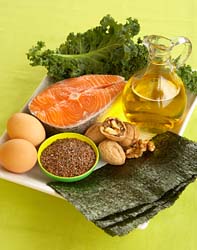
The ratio should ideally be one to four times more omega-6 fatty acids than omega-3 but the average American consumes 11 to 30 times more omega-6 than omega-3.
An article recently posted on a major news organization website entitled "Want to Live Longer? You Need This Nutrient" by Taras Grescoe states:
". . .an ever-growing body of research is showing that the epidemic of diseases associated with the Western diet - cancer, heart disease, depression, and much more - might be curtailed simply by restoring something we never should have removed from our diets in the first place: omega-3 fatty acids."
Eicosanoids and Prostaglandins - How it All Works
In order to grasp just how the imbalance of Omega-6 to Omega-3 fatty acids results in disease in the body, it is first necessary to have a basic understanding of eicosanoids and how they work to promote or impede health. Eicosanoids are hormone-like substances produced from essential fatty acids that serve as catalysts for a large number of physiological processes on a moment-by-moment basis. Because they have their effect and are then rapidly inactivated without entering the bloodstream, it is difficult to isolate or measure them.
An important subgroup of eicosanoids is prostaglandins that are produced by certain enzymes acting on fatty acids. There are three types of prostaglandins derived from different fatty acids that carry out various biochemical effects in the body depending on which type is produced. Here are some of the key functions of various types of prostaglandins and ways they can negatively or positively affect health if they are not produced in the balance the body needs:
Functions of Type 1 Prostaglandin (eicosanoid derived from DGLA)
- Prevents blood platelets from sticking together and forming clots that could cause a heart attack or stroke
- Relaxes blood vessels which improves circulation, lowers blood pressure and relieves angina
- Decreases inflammation response which helps to control inflammatory diseases such as arthritis and asthma
- Opens the bronchi of the lung, increasing oxygen flow
- Improves nerve function and elevates mood
- Improves functioning of T-cells in immune system, reducing risk of cancer
- Keeps arachidonic acid from being released from cell membranes and converting to Type 2
Functions of Type 2 Prostaglandin (eicosanoid derived from AA - arachidonic acid)
- Creates platelet aggregation that can lead to blood clots
- Causes inflammation that can lead to arteriosclerosis, arthritis, asthma, etc.
- Constricts blood vessels that can result in poor circulation and higher blood pressure
- Triggers inflammation that can lead to a variety of inflammatory conditions
- Increase cellular proliferation that can promote more rapid growth of cancer
Functions of Type 3 Prostaglandin (eicosanoid derived from EPA)
- Inhibits release of AA (arachidonic acid) from cell membranes
- Controls inflammatory conditions in similar ways to Type 1 prostaglandin
- Prevents Type 2 prostaglandin production
Omega Prostaglandin Pathways - Getting the Right Balance
Several factors are involved in determining which type of prostaglandin will be activated by the kinds of fatty acids taken in through our diets. Though it is not necessary to fully understand the rather complex variables in these conversion pathways, it is important to realize how the dietary choices we make each day do affect our health on a cellular level. Even more important to understand is that we can protect the pathway our health takes by bringing into balance the ratio of omega-6 to omega-3 in our diets so eicosanoids and prostaglandins function correctly to promote a state of health and balance.
In the first pathway, an omega-3 source of alpha-linolenic acid (ALA), such as flaxseed oil, converts to EPA and, in turn, to either DHA or Type 3 prostaglandin. The conversion to DHA involves several steps and can be difficult and inefficient if certain factors exist such as poor health, stress, aging and a shortage of particular nutrients needed for the conversion process. The biggest factor is that excess dietary omega-6 can use up the key enzyme needed for the conversion of both omega-3 and omega-6 making it unavailable for conversion to EPA and DHA. A study conducted on people over fifty to see how well they converted flaxseed oil to DHA revealed less than 10% was converted to EPA and less than 4% was converted to DHA. However, when fish oil that already contains DHA and EPA is taken, the conversion is already done by the fish, a reason many experts consider fish oil to be the best source of omega 3.
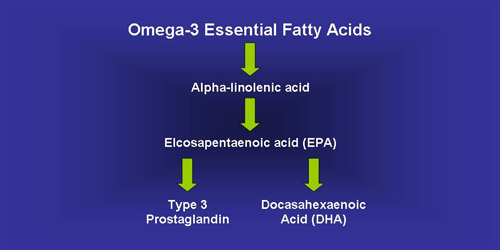
In the omega-6 pathway, linoleic acid from the diet converts to gamma-linoleic acid (GLA) and then to Di-hommo-gamma linolenic acid (DGLA). GLA is a healthy form of omega-6 found in evening primrose oil, borage oil and black current oil, most commonly available in supplement form. The primary factor inhibiting the key enzyme (delta-6 desaturase), crucial for the conversion of LA to GLA, is the presence of trans fats. Other significant factors are: deficiency of nutrients such as B-6, B-12, biotin, protein and zinc, excess consumption of sugar, alcohol, overeating and health conditions like diabetes or thyroid disease.
At this point in the pathway, two things can happen that determine the type of prostaglandin produced. If GLA is produced, it converts to DGLA and forms Type 1 prostaglandins. If the enzyme has been inhibited and dietary or supplemental GLA is not present, it travels the arachidonic acid (AA) pathway where Type 2 prostaglandins are produced. DHGA is the building block of so-called "good" eicosanoids whereas excess amounts of AA tend to form eicosanoids that accelerate the development of chronic disease. One factor that can lessen the amount of omega-6 fatty acids becoming AA is the presence of omega-3 EPA as it works to inhibit the enzyme causing the progression. The higher the concentration of EPA in the diet, the more this enzyme is inhibited and the less AA is available for pro-inflammatory eicosanoid production. In addition, EPA generates its own anti-inflammatory prostaglandins (Type 3).
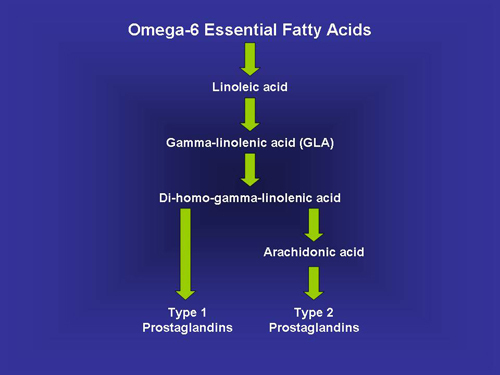
Please bear in mind that this progression of dietary omega-6 turning into AA and then producing Type 2 prostaglandins, resulting in inflammatory and other disease conditions, only occurs because of the imbalance brought on by excess omega-6 fatty acids along with omega-3 deficiency in today's typical diet. Type 2 prostaglandins do have a role to play in health but when too many of them are formed, it more often results in disease. As an example, Type 1 prostaglandin prevents blood platelets from sticking together which serves to thin the blood. That can be great for preventing blood clots that may lead to artery blockage and death but, were it not for the effect Type 2 prostaglandins have with helping blood to clot, the blood could become so thin that a person would bleed to death from a simple cut.
The best way to create a "healthful" balance is to increase dietary sources of omega-3 such as fish oil and decrease omega-6 ones.
In addition to avoiding refined vegetable oils, other foods high in arachidonic acid such as meat, poultry, dairy products, eggs and shellfish, should be limited. However, meat, chicken, eggs and dairy products from pasture or grass fed animals are significantly higher in omega-3 and less high in omega-6 than commercially raised foods from corn and grain fed animals and need not be limited as much. Also, conjugated linoleic acid (CLA) found in cattle and game that feed on grass actually converts more easily into the right kind of prostaglandins. In order to eat these foods and keep your omega-6/omega-3 ratio in balance, it is advisable to purchase organic free-range beef, poultry, eggs and dairy products and increase other omega-3 sources.
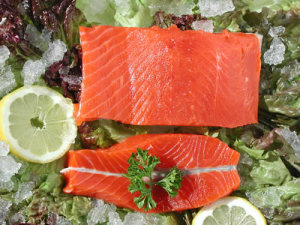 What are the Best Omega-3 Sources?
What are the Best Omega-3 Sources?
The best dietary source of Omega 3 is cold-water fish such as salmon, halibut, albacore tuna, mackerel, lake trout, sardines and herring. Though other low-fat fish or fish from tropical waters are still healthful to eat, they do not contain significant levels of the EPA/DHA oils. Vegetarian sources of omega-3 contain alpha-linolenic acid that must be converted to EPA and DHA. They include various fruits (avocados are especially high) and vegetables (especially dark leafy greens), nuts such as walnut and hazelnut,  seeds such as mustard, pumpkin, hemp, chia and flax seed as well as certain oils such as flax seed and walnut oil.
seeds such as mustard, pumpkin, hemp, chia and flax seed as well as certain oils such as flax seed and walnut oil. 
Flaxseed oil is regarded as the best vegetarian source of omega-3. It should always be kept refrigerated, never heated, and consumed in small amounts in salad dressings and spreads.
A Caution About Too Much Fish
One unfortunate drawback with eating fish in today's world is that caution must be exercised regarding the potential danger of the accumulation of too much mercury or other toxins such as dioxins and polychlorinated biphenyls (PCBs). Microorganisms in bodies of water polluted by industrial waste can convert mercury to a highly toxic form known as methyl mercury. When fish eat these microorganisms, the methyl mercury builds up in the bodies of the fish and could potentially build up in a person's body if too much is consumed. Larger fish, which are higher on the food chain such as shark, swordfish, king mackerel and tilefish, tend to accumulate greater mercury amounts as they generally live longer.
Because these type of toxins could be particularly harmful to the development of the brain and nervous system of the unborn and young children, certain individuals are advised by the Food and Drug Administration and Environmental Protection Agency to limit the amount of fish they eat. Those advised are pregnant women/those trying to become pregnant as well as nursing mothers and young children. 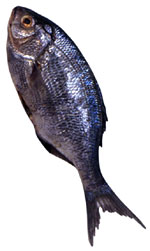 The recommendation is to limit consumption to no more than 12 ounces in a week and no more than six ounces of canned tuna a week. Certain fish, such as wild Alaskan salmon, are safer than others. The Environmental Defense Fund has a very helpful website where complete information can be found on which fish are the best and the worst in regards to levels of toxins. They even have PDF seafood and sushi pocket guides as well as a mobile phone version to help you make the most informed seafood choices while shopping or eating out. The link is: http://www.edf.org/page.cfm?tagID=16283
The recommendation is to limit consumption to no more than 12 ounces in a week and no more than six ounces of canned tuna a week. Certain fish, such as wild Alaskan salmon, are safer than others. The Environmental Defense Fund has a very helpful website where complete information can be found on which fish are the best and the worst in regards to levels of toxins. They even have PDF seafood and sushi pocket guides as well as a mobile phone version to help you make the most informed seafood choices while shopping or eating out. The link is: http://www.edf.org/page.cfm?tagID=16283
Another matter to be noted regarding eating fish for omega-3 benefits is that farm-raised fish do not contain high amounts of omega-3 due to the fact that their feed contains large amounts of soy and corn meal. Though they may be free of mercury and industrial pollutants, their normal health benefits are reduced greatly by the injection of hormones and chemicals that give them the pink color that wild salmon would normally have.
Fish Oil Supplements - A Safer Source
 The good news is that fish oil and cod liver oil from high quality sources do not pose the same risk as fresh fish because they can be purified of mercury, PCBs and other contaminants to a large degree. Many "drug store" and even some health food store and internet brands do not use the process of molecular distillation or meet the strictest standards for contaminants, so it is extremely important to purchase pharmaceutical grade fish oil from companies that provide verification of their testing standards. There are three internationally-accepted standards for testing fish oil: the CRN (Council for Responsible Nutrition), the WHO (World Health Organization) and the IFOS (International Fish Oil Standards), the latter of which has the most stringent and comprehensive standards for quality and purity. For women who are pregnant or breastfeeding, there are safe DHA supplements made from vegan sources such as algae (which are what fish eat to produce it in the first place) or made from smaller fish such as anchovies and sardines which are far less likely to have mercury accumulations. There are even safe DHA supplements for toddlers in liquid form that can be put in beverages.
The good news is that fish oil and cod liver oil from high quality sources do not pose the same risk as fresh fish because they can be purified of mercury, PCBs and other contaminants to a large degree. Many "drug store" and even some health food store and internet brands do not use the process of molecular distillation or meet the strictest standards for contaminants, so it is extremely important to purchase pharmaceutical grade fish oil from companies that provide verification of their testing standards. There are three internationally-accepted standards for testing fish oil: the CRN (Council for Responsible Nutrition), the WHO (World Health Organization) and the IFOS (International Fish Oil Standards), the latter of which has the most stringent and comprehensive standards for quality and purity. For women who are pregnant or breastfeeding, there are safe DHA supplements made from vegan sources such as algae (which are what fish eat to produce it in the first place) or made from smaller fish such as anchovies and sardines which are far less likely to have mercury accumulations. There are even safe DHA supplements for toddlers in liquid form that can be put in beverages.
Conclusion
Though fats have been given a bad reputation, it is important to understand that they are not only a vital part of our diet but also can be key to building health and preventing disease. If you avoid the man-made or man-altered fats and choose instead the right balance and amounts of the healthy fats God designed, you will experience a far greater measure of health.
Copyright © 2008-2015 Lucinda Bedogne, CNHP, CNC
Post Your Comment...
|
|
||||||||||||


